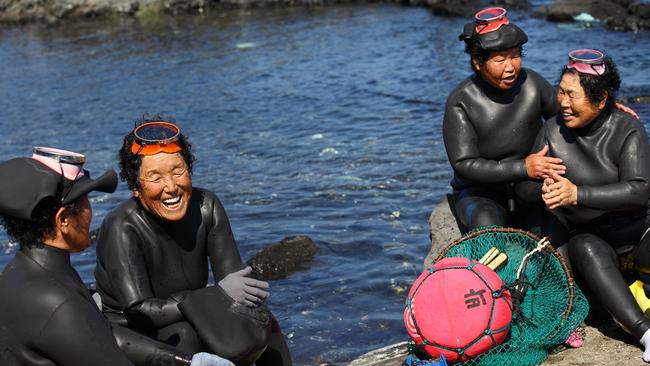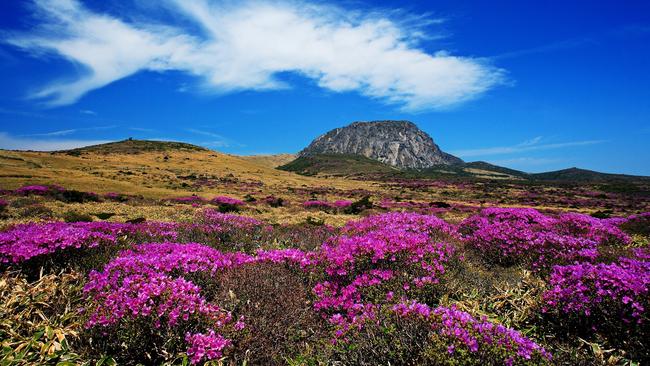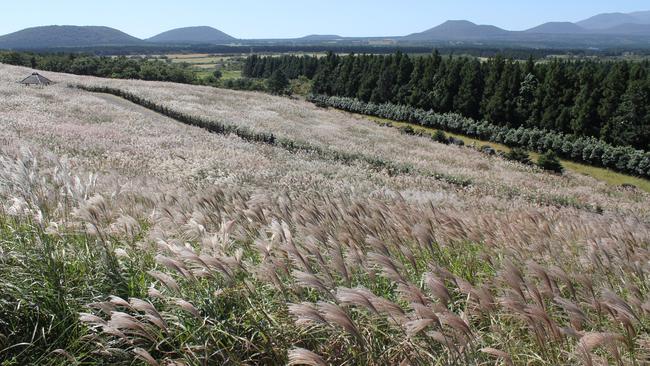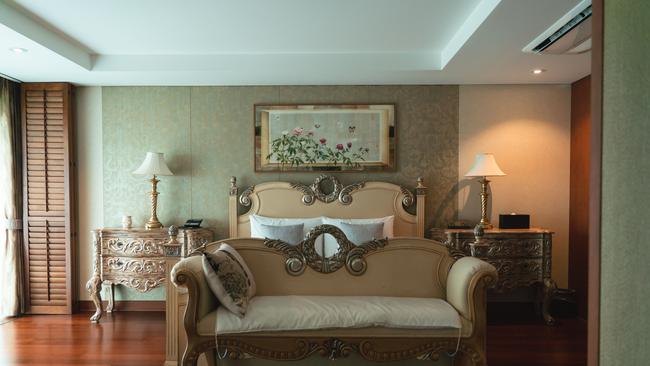South Korea’s amazing women free divers
Jeju is renowned for its dramatic volcanic landscape but there’s another factor that shapes its distinctive identity.

Octopuses dangle from a railing in the autumn sun and windsurfers skim across a white-tipped sea as we follow the coastal road to the volcanic cone etched against the sky. Such scenes transport my mind to the South Pacific, but we are on Jeju, South Korea’s largest island, which lies in the Korea Strait off the country’s southern tip. Home to 700,000 residents and slightly larger than Australia’s Fraser Island, Jeju is sometimes referred to as South Korea’s Hawaii, with its dramatic geology, natural beauty and relative warmth making it a popular holiday destination in a country better known for bustling cities.
Each year more than 13 million visitors seek out its many attractions, including the nation’s highest mountain, the magnificent Hallasan, as well as its web of hiking trails, colourful flora, white sand beaches and plethora of restaurants featuring local offerings such as abalone and sweet-fleshed cutlass fish.
You could climb a different volcanic peak every day for a year on oval-shaped Jeju and still not have conquered them all; 368 cones, known as oreums, are dotted across its 1849sq km. Mount Hallasan and Seongsan Ilchulbong won UNESCO recognition as World Heritage sites in 2007 alongside Jeju’s system of lava tubes, and the entire island became part of the agency’s Global Geopark Network in 2010.
But while its geological formations are astounding, there’s another UNESCO-recognised feature that has helped shape Jeju’s distinctive identity – its remarkable female free divers, known as haenyeo. Added to the list of Intangible Cultural Heritage in 2016 for their work in sustainable fishing and their important community role, the haenyeo have been part of Jeju’s story for hundreds of years.

Working in groups, the women hold their breath for one to two minutes at a time as they repeatedly plunge up to 10m into coastal waters to harvest seafood, including abalone, conch and seaweed. Haenyeo learn this technique, known as muljil, when they are as young as eight and often continue diving into their 80s. Haenyeo are revered, but their numbers fell from 15,000 in the 1970s to fewer than 3500 in 2021. With 90 per cent of working haenyeo now aged over 60, there’s a push to teach a new generation their skills.
Our first opportunity to meet one of these remarkable women comes at Haenyeo Kitchen, an avant-garde theatre restaurant in Jongdal-li village where diners can enjoy a performance celebrating the life of 85-year-old local haenyeo Kim Chun-ok, as well as a buffet featuring conches harvested by the divers. While the show is performed in Korean, its vitality and poignancy transcend language barriers and we are captivated. After the lunchtime performance, Kim arrives in the restaurant to take questions from the audience, discussing her difficult working life and the tragedy of losing relatives in the island’s bloody 1948 political uprising.
Later, guide Sue Jeong translates as Kim tells me she believes Jeju women are stronger than other Korean women thanks to their arduous work and the island’s notorious winds, which force them to speak loudly.

That afternoon, Sue drives us along the picturesque coastal route to nearby Seongsan Ilchulbong to climb the spectacular volcanic formation and hear some haenyeo ballads. One of the most photographed features on Jeju, Seongsan Ilchulbong, also known as Sunrise Peak, was created when an underwater volcano erupted, producing the imposing tuff (ash) cone that now rises castle-like from the ocean. The ascent is steep but well-paved and when we reach the rim we’re rewarded by sweeping views of the island and the cone’s lush green interior.
Back at a cove at the base, five elderly haenyeo have been busy selling their catch, but as 3pm nears they stroll to the rocky foreshore to entertain an appreciative audience with traditional tunes, including a moving song that tells of their yearning for a better life. Just how tough that life is becomes evident at Jeju’s excellent Haenyeo Museum, where oral histories tell of haenyeo giving birth on their boats after a day of diving, and exhibits include the alarmingly thin attire the divers worked in until the introduction of rubber wetsuits in the ’70s.
Visitors to Jeju can enjoy haenyeo fare at restaurants across the island, including the popular Dongbok Haenyeo Restaurant in the north, run by the affable Geum-shik Yang, whose mother and grandmother were both haenyeo. On a lunchtime visit, our table is filled with treats such as a colourful raw fish rice bowl, grilled mackerel and a soup made from sea urchins harvested from the waters outside the restaurant. Washed down with a local peanut-flavoured rice wine, it’s a memorable meal that, like most in Korea, is wonderful value at $15 a head.
Jeju’s distinctive cuisine is one of its drawcards. At Unjeongine Restaurant in the southwest, we’re served a seafood feast featuring braised cutlass fish served in a bubbling red-pepper broth overflowing with prawns, octopus and abalone. The dish is surrounded by other tasty offerings of tile fish, seaweed soup, snow crab, stone pot abalone and a second cutlass fish, grilled to perfection.

On another evening, we visit Sinwoosung Town Restaurant to barbecue succulent cuts of Jeju’s famous black pork. Following Sue’s example, we cover the meat with a spicy soybean paste and wrap it in a lettuce leaf before popping the entire parcel in our mouths, savouring the flavours.
While tourist buses enable visitors to discover the island and its two main hubs, Jeju City and Seogwipo, road signs in Korean and English and the web of scenic interior byways also make it an ideal self-drive destination. As we dart between attractions, we pass a village of traditional thatched houses and long stretches of rock walls made from the black basalt that covers Jeju and features in its famous charismatic “grandfather” sculptures.
But it is a visit to the spectacular Manjanggul lava tube that best illustrates the extraordinary rock foundations of this 1.2 million-year-old island. Extending for more than 7km underground, it includes a 1km stretch that is open to the public. We bid daylight adieu and descend into a Tolkien-like underworld where gleaming walls carry the deep grooves of ancient lava flows and impressive stone formations tell of the sheer energy that once surged below the surface.

Above ground, the rich volcanic soil feeds an abundance of flora, including avenues of cherry blossoms and canola flowers, forests of camellia trees, fields of green tea and citrus orchards groaning with tangerines and juicy hallabongs – all popular ingredients for the nation’s booming K-beauty industry, which promotes the purity of Jeju products.
Our visit coincides with the silvergrass season and we join scores of others in photographing meadows of the soft vegetation surrounding the Sangumburi Crater, with its circumference of more than 2km. It is yet another Instagram-friendly moment. Sue tells us Jeju has become an increasingly desirable destination among South Koreans thanks to the growing number of movies and TV shows shot on the island.
Popular as it is, it still presents visitors with many opportunities for tranquillity, including a new “sound walk” created by avid environmentalist Roid Lee. We head to the scoria tracks of the enchanting Hwasun Gotjawal Forest where Roid equips us with advanced recording devices to capture the sounds of nature as we walk, listening to the wind and bird calls. The concept is new and requires a translator for English speakers, but it’s a charming experience that makes us reflect yet again on the island’s beauty.

More to the story
From private pensions to high-rise international hotels, there’s no shortage of accommodation options on Jeju. But for a stay that reflects the history and natural beauty of the island, the pick of the bunch is the five-star Seaes Hotel & Resort, built within a 100-year-old fishing village on the island’s south coast.
Discreetly set among 5ha of lush landscaped gardens, the boutique property features Jeju’s distinctive black basalt rock walls and trademark thatched roofs. Its 29 guestrooms include five traditional chambers such as the Chodang Suite, where guests can choose from two bedrooms – one furnished with a European bed and the other offering Korean floor mattresses. Antique timber furniture and pitched ceilings with wooden beams add to the charm.
A more modern interior greets guests in the oversized two-bedroom Presidential Suite (pictured), which occupies 109sq m and offers glorious views towards Sangbangsan mountain.
In the immaculate gardens, brown-eared bulbuls flit between bushes and mandarin trees laden with fruit, while crazy stone paths lead to restaurants and an inviting terrace overlooking the ocean. It’s a wonderful setting for a generous breakfast featuring traditional local dishes such as abalone porridge alongside delicious western options.
But towards day’s end, it becomes apparent the terrace is also the best location to sip an evening cocktail and watch the tangerine sun sink below the horizon.
Seaes Hotel & Resort has deluxe standard rooms from about $415 a night; $1630 a night for the Chodang Suite.
In the know
Jeju lies 80km south of the Korean Peninsula and is well serviced by domestic and international flights. One-way 70-minute flights from Seoul are from about $30.
Libby Moffet was a guest of Jeju Tourism Organisation.

To join the conversation, please log in. Don't have an account? Register
Join the conversation, you are commenting as Logout